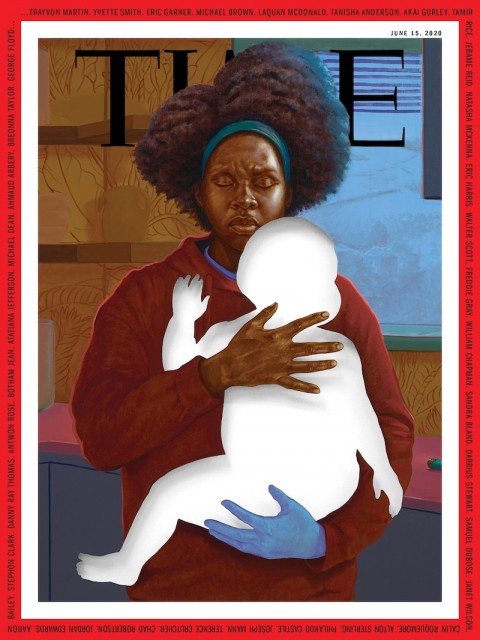Befitting a profile documentary about an artist whose work thoughtfully engages in intellectual activism, Shut Up and Paint is a film unusually occupied by questions of process and power. This makes for a narratively unresolved, but fascinatingly layered piece that eschews tidiness in favor of a poetic struggle, both at the level of its subject and their representation, but also at the level of the filmmaking itself.
The film documents an ethical crisis in the career of one of the art world’s shining stars, Titus Kaphar, as he struggles with the commodification of his work and the surrounding pressure to blunt his activism in the name of marketability. A Black American from humble beginnings, Kaphar rose to prominence via bold, provocative work that “reconfigures and regenerates art history to include the African-American subject“.
Capitalism absorbs dissent though, and Kaphar finds himself pondering his naivete early in the film as the sale price of his paintings moves into the six and seven figures. A gallerist asks if Kaphar could “focus every interview given to (his) painting, to the work, and not the message” as that might help make his work more palatable to curators. Kaphar, exasperated, finds the requests shortsighted to the point of offense—what is his art without the meaning that fuels it? Simultaneously, he ruminates on his recognition in elite Art World circles. Nominally it is a victory for representation that he is able to break through, however, being absorbed into this larger elite (and very white) world means that his art has been largely priced out of the homes of people of color.
The film’s narrative thrust is Kaphar looking at his own art in this self-reflexive manner, so naturally, the filmmaking itself follows suit. Alex Mallis, a prominent New York documentary filmmaker directs, but, does so with Kaphar as his explicit co-director. Mallis’ reasoning is thoughtful, sharing with Short of the Week that, “most non-fiction storytelling severs author from subject and brings into question the nature of power and representation. This is especially true of Black stories told through the lens of white storytellers.”
Thematically, the film documents Kaphar’s efforts to protect his creative process, so, in a sense, this unusual collaboration between director and subject is fitting. It also posed issues though. The film wants to affect a degree of naturalism in an observational style, capturing intimate and authentic moments. How do you do this with a subject that is also an author, and who, as Mallis describes, is “acutely aware of the role and goal of the camera”?
This level of meta-thinking threatens to overwhelm the film at times. Kaphar’s attempt to escape the philosophic quandary of his art is to shoot a film—his reasoning being that film is a much more democratic medium and one that would be more palatable to communities like the one from which he came. Scenes of this film are interspersed throughout Shut Up and Paint, and it is almost one degree of referentiality too far—as an audience, we’re watching a documentary about the making of a short film that is itself the solution to an ethical crisis presented by other people’s reception to separate works of art…with so much going on, it is a wonder that the film is able to maintain its bearings.
Yet, it does and is richer for the messy ambition. If the film does not wrap its narrative in a tidy bow, it is because the questions with which it grapples do not lend themselves to pat solutions. The explicit conundrums of Kaphar’s artistic commodification and the film’s implicit recognition of the documentary medium’s director/subject power imbalance are valuable themes precisely because of the questions they raise rather than the answers they are able to provide. This sort of indeterminacy is rather brave for a documentary I feel, as too often the medium is one that prescribes exactly what its audience is supposed to feel and conclude after viewing.
It might also be part of the basis of the film’s recognized appeal—a Grand Prize winner at the Big Sky Documentary Film Festival, the film played television across the United States as part of public television’s POV program. It is currently in the running for Oscar and on the basis of its inclusion in DocNYC’s “Contender” series and its nomination for this year’s Cinema Eye Honors, it has to be considered one of the favorites to make the cut. Good luck to Kaphar, Mallis, and team, I expect that this is a film we’ll be returning to throughout this awards season.

 Jason Sondhi
Jason Sondhi

